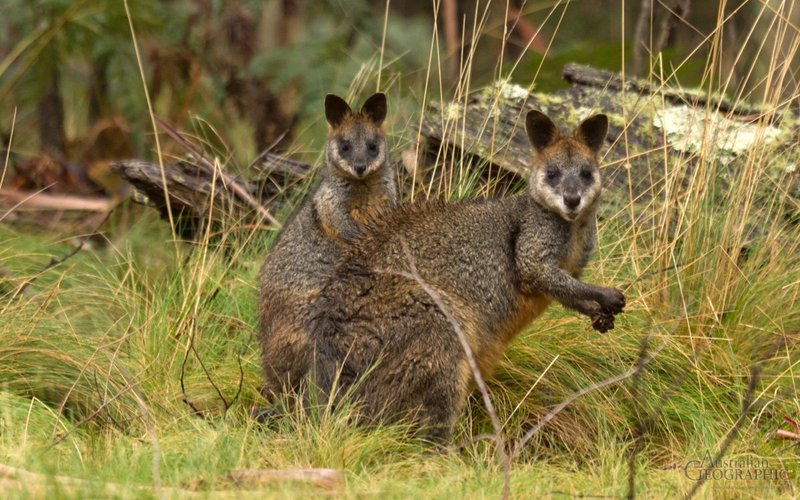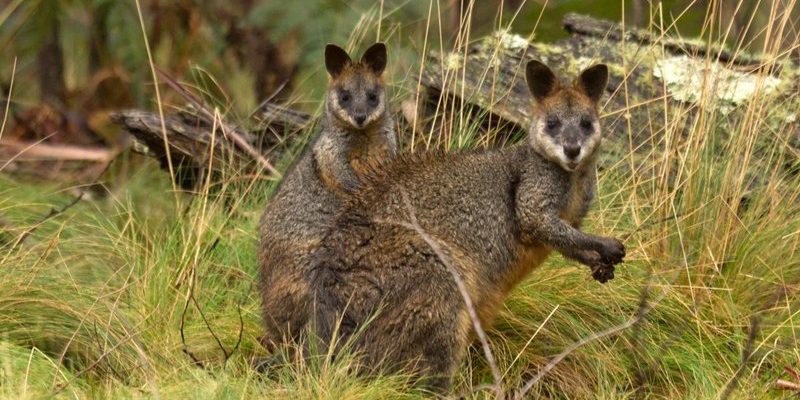
Imagine a creature that’s a bit like a kangaroo, but smaller and with a unique charm all its own. That’s the Swamp Wallaby for you! These fascinating marsupials are native to Australia and are known for their distinctive appearance and adaptability to their environment. They often roam the wetlands and dense forests, hopping gracefully through the underbrush in search of food.
Unlike their larger relatives, Swamp Wallabies have a more compact body and a beautiful coat that can vary from dark brown to a light fawn. With their long, powerful hind legs, they can leap impressive distances, which helps them navigate their often swampy habitats. But there’s so much more to learn about these charming creatures beyond their looks.
If you’re curious about their behaviors, diet, or even what makes them tick, you’re in the right place! Let’s dig deeper into the world of the Swamp Wallaby and uncover some of their most intriguing features.
Physical Characteristics
Swamp Wallabies are striking animals, easily identified by their unique features. Generally, they stand around 70 to 100 centimeters tall, depending on age and sex. The males tend to be larger than females, which is common in many animal species. An adult Swamp Wallaby weighs between 15 to 22 kilograms, making them quite substantial compared to other wallaby species. Their fur is typically a rich brown or gray, often with lighter patches on their underbelly.
One of their most noticeable traits is their robust, muscular build which is designed for agility and strength. Their long, powerful hind legs allow them to make quick leaps, helping them evade predators and navigate their often marshy surroundings. They also have a short, thick tail which helps with balance and stability while moving through uneven terrain.
Curiously, their heads are relatively small in proportion to their bodies, featuring long ears that can swivel to pick up the slightest sounds in their environment. This acute sense of hearing is vital for detecting predators or other dangers that may lurk nearby.
Habitat and Distribution
The Swamp Wallaby thrives in a variety of environments, but they have a particular affinity for dense, wet forests, swamps, and grasslands. They are often found in eastern Australia, particularly in New South Wales and Queensland. These areas provide them with ample cover from predators, as well as plenty of food sources, which include grasses, leaves, and shrubs.
Swamp Wallabies are adept at adapting to their surroundings. You’ll often spot them in areas with thick vegetation, as this allows them to feel secure while they graze. Interestingly, they can adjust their habitat preferences based on local conditions; for instance, during dry spells, they might move to more lush areas where water sources are present.
Another fascinating aspect of their habitat is that Swamp Wallabies are less territorial compared to other marsupials. They tend to form loose social groups, allowing them to share resources more freely. This behavior not only helps with survival but also offers opportunities for interaction with other wallabies.
Diet and Feeding Habits
When it comes to meals, Swamp Wallabies are primarily herbivores, meaning they munch on a diet consisting mainly of plants. Their everyday menu includes leaves, flowers, and various types of grasses. They are particularly fond of tender shoots, which provide essential nutrients and hydration, especially in hotter months.
One interesting characteristic of these creatures is their ability to be selective eaters. They often prefer young, fresh leaves over older foliage, showcasing their instinct for choosing the most nutritious options available. Unlike some other wallabies, Swamp Wallabies can also feed on tougher plant materials, allowing them to thrive in a broader range of habitats.
They usually graze during dawn and dusk, times when it’s cooler and safer from predators. As they munch on their leafy meals, you can see their strong jaw muscles at work, helping them effectively chew and digest their fibrous diet. This grazing behavior plays a crucial role in their ecosystem, as their foraging helps to maintain the health of the vegetation in their habitat.
Reproduction and Lifespan
Reproduction is a vital aspect of the Swamp Wallaby’s life cycle. The breeding season typically spans from late winter to early spring, but these marsupials can breed year-round under favorable conditions. After mating, the female gives birth to a tiny, underdeveloped joey, which crawls into her pouch to continue its development. This pouch acts like a cozy cradle, offering necessary warmth and protection as the joey grows.
The joey will stay in its mother’s pouch for about six months, during which it will gradually start to peek out and explore. Once it’s weaned, the young wallaby often remains close to its mother, learning survival skills and social behaviors. The bond between mother and young is typically strong, helping the joey to become a well-adjusted adult.
In the wild, Swamp Wallabies can live up to 12 years, although those in captivity have been known to reach even older ages. Their lifespan can be influenced by factors such as environmental conditions, predation, and available food sources. Understanding their reproductive habits not only helps us appreciate their life cycle but also aids in conservation efforts.
Behavior and Social Structure
Swamp Wallabies have a unique social structure that often reflects the environment they inhabit. They tend to be solitary animals but can occasionally be seen in small groups, particularly when food is abundant. Their behavior is generally shy and cautious, making them elusive to spot in the wild.
Interestingly, these wallabies are often more active during low-light conditions. They utilize their keen sense of hearing and excellent vision to navigate their surroundings while avoiding potential threats. When they do encounter danger, Swamp Wallabies are known for their quick hops, allowing them to escape rapidly to safety.
Communication among Swamp Wallabies is subtle but effective. They use a series of low grunts and body language to convey messages to one another. These interactions can be crucial during mating seasons, enabling them to establish relationships and determine social hierarchies. Overall, their behavior showcases a remarkable balance of independence and socialization.
Conservation Status
Swamp Wallabies are currently classified as a species of least concern by the International Union for Conservation of Nature (IUCN). However, they face challenges in the wild, primarily due to habitat loss and human activities. Urban development and agriculture have encroached on their natural habitats, putting pressure on their populations.
Interestingly, Swamp Wallabies have shown a remarkable ability to adapt to some degree of habitat modification, often thriving in altered landscapes. This adaptability plays a crucial role in their survival, but it doesn’t eliminate the threats they face. Conservation efforts are essential to ensure their populations remain stable and healthy.
Protecting wetlands and forest areas is vital for their continued existence. Awareness and education about the importance of these habitats can empower communities to engage in conservation initiatives, ensuring that the Swamp Wallaby and other wildlife can thrive for generations to come.
Interesting Facts About Swamp Wallabies
| Size: | 70-100 cm tall |
| Weight: | 15-22 kg |
| Diet: | Herbivore (leaves, grasses, flowers) |
| Lifespan: | 12 years in the wild, longer in captivity |
| Habitat: | Wetlands, forests, grasslands |
| Predators: | Dingo, eagles, foxes |
FAQ
Where can I find Swamp Wallabies in the wild?
Swamp Wallabies are primarily found in eastern Australia, particularly in regions like New South Wales and Queensland. They thrive in wetland habitats, dense forests, and grasslands, where they have access to ample food and cover. If you’re hoping to spot them, it’s best to look during dawn or dusk when they are most active.
What do Swamp Wallabies eat?
These fascinating marsupials are herbivores, meaning they primarily consume plants. Their diet consists mainly of leaves, young shoots, flowers, and various grasses. They have a preference for tender and fresh vegetation, which provides the nutrients they need to thrive. Swamp Wallabies are also known for being selective eaters, choosing the most nutritious options available.
How do Swamp Wallabies reproduce?
Swamp Wallabies typically breed during the late winter to early spring, although they can mate year-round in favorable conditions. After mating, the female gives birth to a tiny joey, which immediately crawls into her pouch. The joey remains in the pouch for about six months, developing and growing before it begins to venture out.
What is the lifespan of a Swamp Wallaby?
In the wild, a Swamp Wallaby can live up to 12 years. However, those in captivity often live longer due to better food availability, protection from predators, and medical care. Their lifespan can be influenced by environmental conditions and the availability of resources in their habitat.
Are Swamp Wallabies social animals?
While Swamp Wallabies are primarily solitary, they can occasionally be seen in small groups, particularly when food is plentiful. Their social structure is quite fluid, and they utilize communication through sounds and body language. However, they are generally shy and prefer to keep a safe distance from one another.
How do Swamp Wallabies avoid predators?
These clever creatures rely on their agility and keen senses to escape from predators. When threatened, they can make quick, powerful hops to evade danger. Their strong hind legs enable them to leap long distances, helping them to quickly find safety in dense vegetation. Their acute sense of hearing also plays a crucial role in detecting potential threats.
What threats do Swamp Wallabies face?
While Swamp Wallabies are currently classified as a species of least concern, they still face significant threats. Habitat loss due to urban development and agriculture poses challenges to their populations. Additionally, they may fall prey to natural predators such as dingoes, eagles, and foxes. Conservation efforts are essential to protect their habitats and ensure their survival.
Can Swamp Wallabies adapt to urban environments?
Interestingly, Swamp Wallabies have shown some adaptability to altered landscapes, which can include urban areas. While they thrive in natural habitats, they can sometimes find food and shelter in modified environments. However, it’s essential to balance urban development with wildlife conservation to ensure their well-being.
Are Swamp Wallabies endangered?
Currently, Swamp Wallabies are not considered endangered; they fall under the “least concern” category by the IUCN. However, ongoing habitat loss and environmental changes mean that conservation efforts remain vital to ensure their populations stay stable and healthy in the long run.
How can I help protect Swamp Wallabies?
Conservation efforts can start right in your own community! Supporting local wildlife organizations, advocating for habitat preservation, and raising awareness about the challenges faced by Swamp Wallabies can all make a difference. Additionally, practicing responsible land use, such as reducing pollution and protecting natural areas, will help ensure a safe environment for these remarkable creatures.

